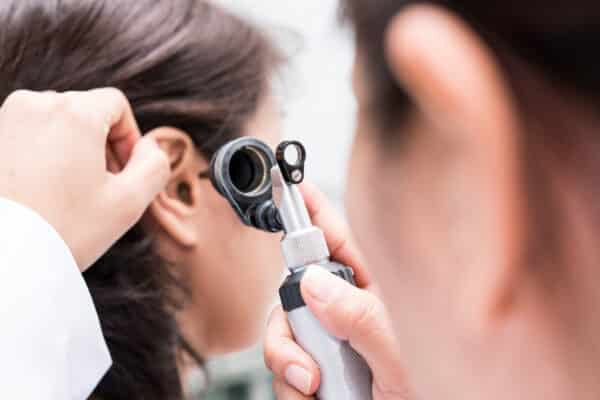EUSTACHIAN TUBE DYSFUNCTION
Significant Relief For Patients Who Need Ear Tubes
What is Eustachian Tube Dysfunction (ETD)?
The Eustachian tube is a small passageway that connects your throat to your middle ear. When you sneeze, swallow, or yawn, your Eustachian tubes open keeping air pressure and fluid from building up inside your ear. These passageways are small and can get plugged for various reasons. Blocked eustachian tubes can cause pain, hearing difficulties and a feeling of fullness in the ears. Such a phenomenon is referred to as eustachian tube dysfunction (ETD). When this happens, sounds may be muffled and your ear may feel full. You may also have ear pain.
ETD is a relatively common condition. Depending on the cause, it may resolve on its own or require a trip to see board certified otolaryngologist (ENT), Dr. Lenkowski. Severe or recurring cases may require specialized care from the doctor. Dr. Lenkowski is dedicated to improving your quality of life and partnering with you to find the best treatment for your needs. His kind and pleasant demeanor along with his vast experience in the ENT and allergy field will ensure that you and your family receive top-notch care.
How We Treat ETD
Get the Relief You Need
As a board certified otolaryngologist (ENT), Dr. Lenkowski is equipped to expertly treat ETD. Each ETD case is unique and the team will work with you to determine the best treatment as a solution for your pain. It’s time for a solution and our team is here to help.
- ALLERGY TREATMENT – Identifying and treating nasal allergies may help to reduce the swelling in the lining of the eustachian tube. Dr. Lenkowski and his allergy center team are relentless in finding a solution and improving your quality of life.
- Identifying the particular allergen(s) and eliminating it from the environment
- Giving allergy shots, though it may take a long time to notice beneficial effects
- Giving intranasal steroids to reduce inflammation of the mucosal lining of the nose.
- Learn more about our allergy services
- MEDICATION – Some patients can be treated with prescription medications including antibiotics for infections and oral corticosteroids for severe inflammation.
- SURGICAL PROCEDURES – When relief for ETD cannot be found with medications or time, it may be necessary for Dr. Lenkowski to consider the use of surgical procedures.
- Myringotomy – Dr. Lenkowski will make a tiny incision in the eardrum and suction out any fluid in the middle ear. In adults, the incision often stays open long enough to allow the swelling in the Eustachian tube lining to resolve. usually within one to three days. The procedure takes about five minutes and can be performed in the office using a topical anesthetic. After the eardrum heals, if the Eustachian tube lining has not recovered, fluid in the middle ear fluid may begin to re-accumulate.
- IMPLANTING PRESSURE EQUALIZATION TUBES (PETs) – Dr. Lenkowski will make a tiny incision in the eardrum and suction out any fluid in the middle ear. The doctor will insert a tiny hollow tube made of plastic or metal into the eardrum. These tubes help to equalize ear pressure and mitigate frequent or chronic middle ear infections by allowing fluid to escape. Children get tubes most frequently due to the number of ear infections they get. The tubes stay in up to 18 months and fall out on their own. If the patient has a more chronic condition, Dr. Lenkowski can use longer-lasting tubes. For tube place, Dr. Lenkowski will use a light general anesthetic to keep the patient still during the procedure.
- ET DILATION – Dr. Lenkowski will use a catheter (long, flexible tube) to insert a small balloon through your nose and into the Eustachian tube. When it is inflated, the balloon opens a pathway for mucus and air to flow through the tube. This can help it function properly. The Balloon Sinuplasty is an in-office procedure offering patients quick relief from chronic sinus problems including infections, headaches, stuffiness and runny nose. After the Balloon Sinuplasty procedure, patients suffering from long-standing sinus disease can recover faster at home as there is no cutting of the nasal tissue. Dr. Lenkowski and his team at ROVA ENT are pleased to be able to offer these life-changing procedures to the great community of Roanoke Valley. Read more about the balloon dilation procedure.
Symptoms of Eustachian Tube Dysfunction (ETD)
- Ears may feel plugged or full.
- Sounds may seem muffled.
- May feel a popping or clicking sensation in ears.
- Children may say their ear “tickles”.
- Pain in one or both ears.
- Ringing in your ears (called tinnitus).
- May sometimes have trouble keeping your balance.
- Altitude changes may cause symptoms to get worse. This includes flying in an airplane, riding in elevators, driving through mountains or diving.
Suffering from chronic ear pressure and pain or discomfort in the ears for weeks? The length of time that ETD symptoms last depends on the initial cause. Symptoms from altitude changes, for example, may resolve once you get back to the altitude you’re used to. Illnesses and other causes of ETD may result in longer-lasting symptoms. Often the symptoms can only be relieved with the help of an experienced ENT.
Are you ready to find relief for these systems? Request an appointment with board certified otolaryngologist (ENT) Dr. Lenkowski and his team in Roanoke, Virginia.
What causes Eustachian Tube Dysfunction (ETD)?
The most common cause of ETD is when the tube gets inflamed and mucus or fluid builds up. This can be caused by a cold, the flu, a sinus infection or allergies.
Some people are at greater risk for ETD, including:
- Children. Their tubes are shorter and straighter than those of an adult making it easier for germs to reach the middle ear and for fluid to become trapped there. Also, children’s immune systems are not fully developed making it harder for them to fight off infections. Children are more likely to see a doctor for ETD than adults because they are at an overall higher risk of getting ear infections. The pain from ETD can mimic the pain from an ear infection.
- Smokers. Smoking damages the cilia (the tiny hairs that sweep mucus from the middle ear to the back of the nose) allowing mucus to gather in the tubes.
- Overweight People. Fatty deposits around the tubes can lead to ETD.
- Allergy Sufferers. People with allergies may experience more mucus and congestion, leading to increased risk.
How is Eustachian Tube Dysfunction (ETD) Diagnosed?
If your doctor has said you need to go see an ENT specialist for ETD because the symptoms are lasting too long, Dr. Lenkowski will partner with you to find the best treatment for your needs. His kind and pleasant demeanor along with his vast experience in the ENT and allergy field will ensure that you and your family receive top-notch care.
ETD and its severity are diagnosed through a physical exam. First, Dr. Lenkowski will ask you about pain, hearing changes or other symptoms you are experiencing. Then, he will look inside your ear canals and eardrums, your nasal passages and the back of your throat.
Ready to see a specialist who knows how to treat your ETD? Get relief now, request an appointment with board certified otolaryngologist (ENT)Dr. Lenkowski and his team in Roanoke, Virginia. Let us help you find relief today.
Can allergies cause Eustachian tube dysfunction?
How is Eustachian tube dysfunction diagnosed at Roanoke Valley ENT & Allergy?
What non-surgical treatments does Roanoke Valley ENT & Allergy offer for Eustachian tube dysfunction?
What are the long-term effects of untreated Eustachian tube dysfunction?
How does the Eustachian tube balloon dilation procedure work?
Can children undergo treatment for Eustachian tube dysfunction?
How does flying affect Eustachian tube dysfunction?
What is the success rate of treatments for Eustachian tube dysfunction at Roanoke Valley ENT & Allergy?
REQUEST YOUR
ENT APPOINTMENT
"*" indicates required fields
REAL PATIENTS.
REAL RESULTS.
“For years I have experienced chronic ear issues with eczema. Dr. Lenkowski’s diagnosis and treatment was spot on. He answers all of my questions and is quite caring which is important to me. I highly recommend him to anyone seeking a great ENT.”
“Dr. Lenkowski was interested in the reason I was there to be checked, he thoroughly examined my ears, nose, throat and neck and ask questions. When I was ready to leave he told me to come back if I had any other problems. I would recommend Dr. Lenkowski to any of my family members or friends.”
“Very personable and knowledgeable Doctor with a very pleasant manner. Would definitely recommend!”
“Very knowledgeable and explained the issues in a very articulate manner. I was impressed with the amount of time he was willing to allow me to discuss other concerns. I highly recommend him to anyone wanting an excellent ENT specialist.”
OFFICE HOURS
MONDAY – FRIDAY
8 am-5 pm
PHONE
CALL: 540-655-1888
FAX: 844-212-0402
Paul Lenkowski, M.D., Ph.D., is a board certified Otolaryngologist (ENT) and an accomplished head, neck and sinus surgeon. He is passionate about his job and helping his patients. Dr. Lenkowski is dedicated to improving your quality of life and partnering with you to find the best-individualized treatment for your needs. His kind and pleasant demeanor along with his vast experience in the ENT and allergy field will ensure that you and your family receive top-notch care. Dr. Lenkowski earned his B.S. in Chemical Engineering from Rutgers University and went on to receive his M.D. and Ph.D. as part of the Medical Scientist Training Program at the University of Virginia. He completed his Otolaryngology Residency at the University of Iowa.



